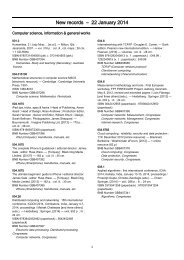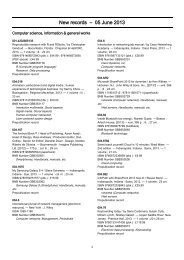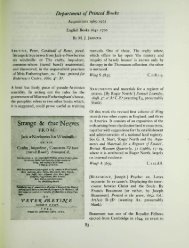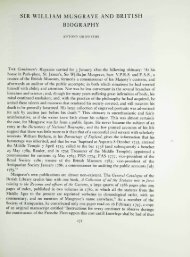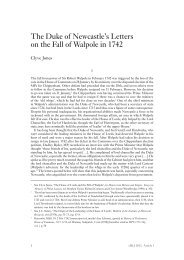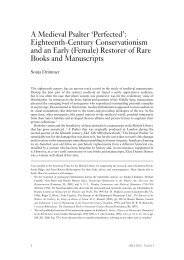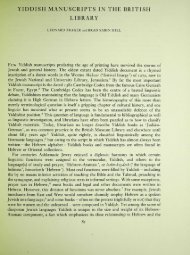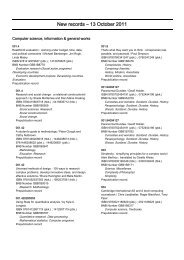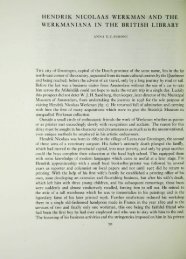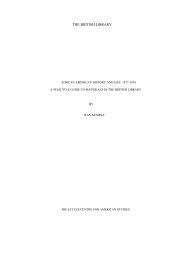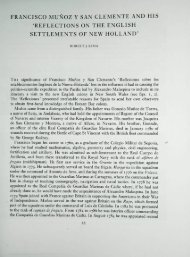MANUAL OF ANALOGUE SOUND RESTORATION ... - British Library
MANUAL OF ANALOGUE SOUND RESTORATION ... - British Library
MANUAL OF ANALOGUE SOUND RESTORATION ... - British Library
You also want an ePaper? Increase the reach of your titles
YUMPU automatically turns print PDFs into web optimized ePapers that Google loves.
y, the groove. “Tracking” concerns the alignment of the reproducer compared with the<br />
geometry of the original cutting lathe.<br />
4.2 Basic turntable principles<br />
I assume my readers know what a turntable is, but they may not be aware that the<br />
equivalent for cylinder records is called a “mandrel.” My first words must be to encourage<br />
you to use “a good turntable (or mandrel) and pickup”. It isn’t easy to define this; but to<br />
recover the best power-bandwidth product, the unit must have a lower background-noise<br />
and a wider frequency-range than any of the media being played on it. This is something<br />
we can measure, and does not need any “black magic.”<br />
The unit should also have reasonably stable speed, although we shall come to a<br />
technique in section 4.16 where this need not necessarily be to the highest standards. In<br />
Chapter 4 we shall be studying the problem of establishing the correct playing-speed for<br />
rogue records. These are in the minority, but at least one machine must have variable<br />
playing-speed so this matter may be researched. (It may be necessary to have two or<br />
more machines with different features to get all the facilities).<br />
The unit should be insulated so it is not significantly vibrated by sounds from the<br />
loudspeakers, loose floorboards, etc; this may mean fixing it to a massive mounting-plate,<br />
and suspending it in compliant supports. All this is good engineering practice, and needs<br />
no further comment from me.<br />
Rather more difficult to define is that the unit should have “low colouration.” This<br />
is much more a black magic subject. Basically it means that the wanted sounds are<br />
reproduced without “hangover” - that is, the machinery should not contribute resonances<br />
or sounds of its own which continue after the wanted sounds have stopped.<br />
The main point about hangover is that the stylus and record themselves generate<br />
it. As the stylus is vibrated by the groove, reaction-forces develop in the disc or cylinder<br />
itself. It is important that such vibrations are quelled instantly, especially in the presence of<br />
clicks and pops. When we remove these clicks and pops using electronic techniques, we<br />
may not be able to get a clean-sounding result if hangover exists in the record itself or the<br />
pickup arm.<br />
To deal with the record first. We cannot prevent the vibrations being set up; we<br />
can only ensure they are eliminated as quickly as possible. One method is to use a heavy<br />
rubber turntable-mat in close contact with the back of the disc. The only suitable kind of<br />
mat is the kind with a recessed area about four inches across in the middle, so the disc<br />
makes good contact irrespective of whether the label-area is raised or not. As I say, it<br />
helps if the mat is thick and heavy; the kind with lightweight ribs is pretty ineffective.<br />
Some vibrations can also be attenuated by a clamp - a heavy weight placed over the<br />
record label.<br />
The Pink Triangle Turntable is designed without a mat at all. It is made from a<br />
plastics material of the same specific gravity as vinyl. Any vibrations set up in the vinyl are<br />
efficiently conducted away without being reflected back towards the pickup. Basically this<br />
is a good idea, but it cannot give perfect reproduction unless the disc is in intimate contact<br />
all over. You should be prepared to flatten warped records to cut down wow and tracing<br />
errors, anyway; please see Appendix 1 for details. In my experience, Pink Triangle’s<br />
method is as good as the best turntable mats, but not better.<br />
I can see no virtue in “anti-static” turntable mats, especially ones that aren’t thick<br />
and heavy. A more suitable method of neutralising electrostatic charges is to keep an<br />
43



